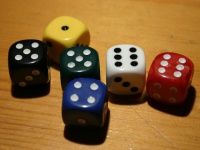KAlgebra/Probabilities
This page shows some uses of KAlgebra in probabilities problem
Introduction
Let's say we have 5 dices and we want to gamble with them.
{

| my text|}
Theory behind game
First we have to analyze one die:
The probability to get a number on a dice is 1/6 or 16,667% because the total numbers of events is 6 and the die is equiprobal.
The probability to get each number is on the left
1 16.667%
2 16.667%
3 16.667%
4 16.667%
5 16.667%
6 16.667%
When we launch 2 dices probabilities change, so we report them:
2 2.778%
3 5.556%
4 8.333%
5 11.111%
6 13.889%
7 16.667%
8 13.889%
9 11.111%
10 8.333%
11 5.556%
12 2.778%
Why is the probability for each number so different respect to first one, you may ask, the solution is very simple. Let's take '4' and make all the combinations of 2 numbers that summed gives 4:
1+3 = 4 3+1 = 4 2+2 = 4
So we have to sum the probability of these numbers to get the total probability of 4. Let's test it:
Prob(1,3) + Prob(3,1) + Prob(2,2) = 1/6 * 1/6 + 1/6 * 1/6 + 1/6 * 1/6 = 0.08333 = 8,333%
So if we have 5 dice, we should get for each resulting number the 5 numbers on dice that summed up give us it. The way to get the probabilities of each number with more dices is equal.
The probability problem
Now we mind at a problem, if we roll our 5 dice and we want 3 '6', what is the probability to get them?
ok, the problem is: probability on first dice * probability on second dice * probability on third dice * negative probability on fourth * negative probability on fifth
So for instance the dice can be: 6 6 6 2 3, but they can also be 5 6 6 6 1, so we have to introduce a binomial coefficient to count all this cases. To have the the binomial coefficient of N numbers on M position the formulae for KAlgebra is:
factorial(N) / (factorial(M) * factorial(N-M))
or simply:
comb(N,M)
So the binomial coefficient of 3 numbers on 5 position is:
comb(5,3)
= 10
so at last our function will be:
(comb(5, 3)*(1/6)*(1/6)*(1/6)*(5/6)*(5/6))
= 0.0321502
We can now define a simple function to get the result:
probability:=(place, case, totalprobability, positive, negative)->
(comb(place, case)*(positive/totalprobability)^case)*(negative/totalprobability)^(place-case)
So now:
probability(5, 3, 6, 1, 5)
= 0.0321502
It's the probability on 5 extraction to get 3 identical number where the probability of each card is 1/6 and the negative probability is 5/6
We can notice that the sum of probabilities is 1:
sum(probability(5, t, 6, 1, 5):t=0..5)
= 1
We can think that the probability progress until the maximum value and then it decrease constantly as it has progressed. So we can see that the distribution of numbers among the extraction is like a bell, this kind of distribution is called distribution.
So now we understand that the game is non balanced, there are probabilities better than other so who choose the best can win easily.
The only way to have a fair game is to gambling with only one die because each face has 1/6 of probability. Another type of equiprobal chances are the launch of a coin where each face is 1/2 of probability.
A simple way where a player can win is to improve the probability on a face so it will be unbalanced, for istance the bank in a game can put a small load on the face with '6' so the probabilities change and the dice now became:
0.15 1
0.15 2
0.15 3
0.15 4
0.15 5
0.25 6
So now if we roll the 5 dices with this probability and we want 3 '6' to win the total probability is:
probability(5, 3, 6, 2, 4)
=0.164609053498
Real World Example
There are two person, the bank and the player. The player can choose to put a bet on how much times the number 6 is extracted at the same time on all 5 dices, if the times he said is right he'll win the prize, otherwise he'll lose and bank will win. The prize is 6$ for each 6 he bet, so if i will bet that there will be 3 dices with 6, he will win 18$.
If the number of die is more than 1 it's naturally a easily win for bank as we saw earlier, but if the die is unique it's equiprobal and bank and user should't win or lose.
Let's take an example:
User bet on extracting 2 6
Probability for user:
probability(5, 2, 6, 1, 5)
probability(5, 2, 6, 1, 5)
